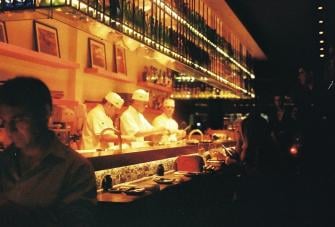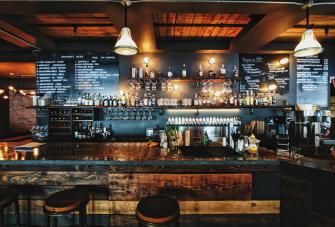Guide to Understanding Restaurant Profit & Loss Statements
As a restaurant owner, managing your restaurant's profit and loss (P&L) statement is like keeping track of the heartbeat of your business. It's where all the hard work, passion, and dedication you put into your restaurant comes together in a single number, either cheering you on or giving you a wake-up call.
But let's face it—P&L management is no easy task. It involves getting into the details of your finances, from meticulously tracking every dollar coming in and going out to managing costs that seem to have a mind of their own, especially when food prices keep fluctuating.
To really take control of your restaurant's financial well-being, you need to start by getting your sales reporting right and mastering the art of keeping your expenses in line.
So let's dig in, understand what a restaurant P&L statement is, why it's so crucial, and learn how to handle it like a pro.
Understanding restaurant P&L statements
A restaurant profit and loss (P&L) statement (also known as a restaurant income statement) gives you a breakdown of all the money coming in and going out over a certain period, whether it's a month or a year.
Now, why does it matter? Well, for starters, it tells you whether you're making a profit or taking a hit. But it's not just about the big picture. The income statement also helps you zoom in on the details. You can see which parts of your business are bringing in the dough and which ones might need a little TLC.
For example, let's say your dinner service is booming, but your lunch crowd isn't quite cutting it. This insight allows you to adjust your strategies and focus on areas that need improvement, such as team scheduling, ultimately helping your restaurant thrive.
Creating your restaurant profit and loss statement
In this section, we'll walk you through the process step by step, ensuring you have all the tools and insights needed to compile an accurate and insightful financial report for your restaurant accounting.
Choose your timeframe
Deciding on the timeframe for your restaurant's profit and loss statement is like choosing the lens through which you'll view your business's financial snapshot. You've got options: weekly check-ins, monthly rundowns, quarterly reviews, or annual deep dives. Whatever you choose, the key is consistency. Regular updates help you stay on top of how your business is doing and spot trends early.
Now, grab your statement sheet and note down the timeframe you've picked for your data. This simple step sets the stage for organizing your financial info and gives you a clear focus as you dive into analyzing your restaurant's performance.
Record sales for the timeframe you've chosen
This section provides a clear snapshot of how much money your restaurant brought in during the chosen period. In a standard income statement template, you'll find sections for food, wine, beer, liquor, and soft drink sales.
You have the option to refine your sales tracking further by breaking down food sales into specific categories or menu groups. Alternatively, you can keep it straightforward by dividing sales into broader categories like food, alcohol, and non-alcoholic beverages.
TIP: If you have a restaurant POS system, such as Epos Now's complete restaurant solution, that offers sales tracking and reporting, you can easily access detailed sales information for your selected timeframe.
Enter in your Cost of Goods Sold (COGS)
Let's talk about the cost of goods sold (COGS). It's basically the cost of all the stuff you used up to make those delicious dishes and drinks during the timeframe you've chosen.
Here's where things get interesting. Ever heard of recipe costing? Not only does it help you calculate COGS, but it's also super handy for working out the cost of each dish on your menu.
Let me break it down for you with an example: Say you sold 10 of your mouth-watering pasta dishes, and each one costs you about $5 to whip up, based on your recipe costs. That means your COGS for those pasta dishes would be 50 bucks (10 dishes x $5 each).
Add your restaurant labor cost
Your staff are the heartbeat of your restaurant, but restaurant labor costs can eat into your profits if you're not careful.
First off, you've got your hourly and salaried employees. Hourly folks are the ones clocking in and out, while salaried employees are on a fixed salary.
To calculate your labor costs, you'll need to tally up how much you're paying everyone for the hours they worked during your selected timeframe. Don't forget to include payroll taxes and any other related costs.
Once you've got that total, you can compare it to your total sales to see how much of your revenue is going towards labor. This ratio gives you a good idea of whether you're spending too much or just enough on labor to keep things running smoothly.
Figure out your operating expenses
Alright, now let's talk about the nuts and bolts of running your restaurant: operating expenses.
These are the expenses that keep your restaurant up and running day in and day out. We're talking about everything from rent and utilities to insurance, marketing, and maintenance costs.
Operating costs can vary widely depending on the size and location of your restaurant, as well as your specific business model. But one thing's for sure: they can add up fast.
To keep tabs on your operating costs, it's crucial to track all your expenses diligently. That means keeping receipts, invoices, and records of every penny you spend on keeping your restaurant running smoothly.
Once you've got a handle on your operating expenses, you can compare them to your total revenue to see how much of your income is going towards keeping the lights on. This ratio gives you a good sense of your restaurant's financial health and can help you identify areas where you might be overspending.
Factor in occupancy expenses
Your occupancy expenses encompass everything related to your restaurant's physical space, from rent and property taxes to maintenance expenses. These costs can vary depending on factors like location, square footage, and lease terms.
To stay on top of your occupancy expenses, it's essential to meticulously track your lease agreements, property tax bills, and any other related costs. This ensures you have a clear understanding of how much you're spending on maintaining your restaurant's premises.
By comparing your occupancy costs to your total revenue, you gain insight into how much of your income is allocated to keeping your restaurant space operational. This comparison helps you assess the financial impact of your occupancy expenses and make informed decisions about your space management.
Account for depreciation
Depreciation is the process of allocating the cost of tangible assets over their useful life. In simpler terms, it's recognizing the gradual decrease in the value of assets like equipment, furniture, and vehicles over time.
For example, let's say you purchase a new oven for your restaurant. While the oven might have a useful life of 10 years, it gradually loses value each year due to wear and tear and technological advancements. Depreciation allows you to spread out the cost of the oven over its useful life, rather than recording the entire expense in a single year.
Understanding depreciation is crucial for accurately reflecting the true value of your assets on your financial statements. It also impacts your restaurant's profitability and tax liability.
To calculate depreciation, you'll need to consider factors such as the initial cost of the asset, its useful life, and any salvage value. There are different methods of depreciation, including straight-line depreciation and accelerated depreciation, each with its own set of rules and calculations.
By properly accounting for depreciation, you can ensure that your financial statements provide a true and fair view of your restaurant's financial position over time.
Analyzing your restaurant’s profit and loss statement
Now, let's break down how to make sense of your restaurant's profit and loss statement. Here's a step-by-step guide on how to analyze this crucial financial document:
Review the percent of sales
Start by examining the breakdown of expenses as a percentage of total sales. This section gives you insights into how much of your revenue is being allocated to different cost categories such as labor cost, rent, food costs and beverage costs, and operational expenses. Look for any significant deviations from industry benchmarks or your historical data, as these may indicate areas that require attention.
Interpret gross profit and gross profit margin
Evaluate your gross profit and gross profit margin to understand how efficiently your restaurant is generating revenue. Gross profit measures the profitability of your core business activities by subtracting the direct costs of goods sold (COGS) from total food and beverage sales. The gross profit margin, expressed as a percentage, indicates the proportion of revenue retained after accounting for COGS. A healthy gross profit margin suggests efficient cost management and pricing strategies.
Assess net profit/loss
The net profit or loss figure represents the bottom line of your restaurant's financial performance. A positive net profit indicates that your restaurant is profitable, while a negative net profit suggests that your expenses exceed your revenue, resulting in a loss. Analyze trends in net profit over time to identify areas of improvement and address underlying issues affecting profitability.
Compare to industry benchmarks
Benchmark your restaurant's performance against industry standards to assess its competitiveness and identify areas for improvement. Compare key financial ratios, such as gross profit margin and operating expenses as a percentage of food and beverage sales, to industry averages to gauge your restaurant's relative performance.
Identify trends and patterns
Look for trends and patterns in your restaurant profit and loss statement to uncover insights into your restaurant's financial performance. Analyze changes in revenue, expenses, and profitability over time to identify areas of strength and weakness. Pay attention to seasonal fluctuations, market trends, and external factors that may impact your restaurant's financial performance.
Make informed decisions
Use the insights gained from analyzing your restaurant profit and loss statement to make informed decisions to improve your restaurant's profitability. Develop strategies to optimize costs, increase revenue, and enhance operational efficiency based on the findings of your analysis.
Take control with a responsive restaurant POS
Host with confidence when you rely on Epos Now’s dedicated restaurant POS. Process multichannel sales (from in-house, takeaway, and delivery) all in one place!
Budgeting and forecasting for restaurant success
Now that you've got a handle on analyzing your restaurant's profit and loss statement, it's time to look ahead and plan for success with effective budgeting and forecasting. Think of it as mapping out the road ahead for your restaurant's financial journey.
- Creating a restaurant budget: Start by listing all your income sources, like food and beverage sales, catering services, or merchandise sales. Then, jot down all your expenses, from food and labor costs to rent, utilities, and marketing. Be realistic, and don't forget to budget for unexpected expenses or emergencies.
- Forecasting sales and expenses: Look at past sales data, market trends, and economic indicators to estimate future revenue. Consider factors like seasonality, special events, and changes in consumer behavior. Similarly, forecast your expenses by projecting costs for ingredients, labor, rent, and other overhead expenses.
- Monitoring and adjusting budgets: Keep a close eye on your financial statements, compare actual results to your budgeted figures, and identify any variances or deviations. If you notice that certain expenses are higher than expected or sales are lower than projected, don't hesitate to adjust your budget accordingly.
- The 30/30/30/10 rule: Allocate your revenue according to the 30/30/30/10 rule. Reserve approximately 30% for food costs, 30% for overhead expenses, and 30% for labor costs. The remaining 10% should be your profit margin. This rule provides a balanced approach to budgeting, ensuring that you maintain profitability while covering essential expenses and investing in the growth of your business.
- Using budgets and forecasts for decision-making: Your budget and forecast are powerful tools for making informed decisions about your restaurant's operations. Use them to evaluate pricing strategies, menu offerings, staffing levels, and marketing initiatives. Consider different scenarios and their potential impact on your bottom line.
- Tools and resources for budgeting and forecasting: Fortunately, you don't have to navigate the world of budgeting and forecasting alone. There are plenty of tools and resources available to help you streamline the process and gain valuable insights into your restaurant's finances. From budgeting software and forecasting templates to online guides and tutorials, take advantage of these resources to make budgeting and forecasting a breeze.
How can a restaurant POS help?
A point of sale system is a powerful tool that can streamline operations, enhance customer service, and improve profitability for restaurant operators and owners. Here are several ways a restaurant POS can benefit your business and contribute to a profitable operation while optimizing the restaurant's finances:
- Streamlined operations: A restaurant POS automates key processes such as order taking, payment processing, and inventory management, reducing manual errors and saving time for restaurant staff. By optimizing workflow, POS systems enhance operational efficiency and contribute to a more profitable business.
- Enhanced customer service: With features like table mapping and order routing, POS systems enable faster order processing and table turnover, allowing staff to provide prompt and attentive service to customers. This results in improved customer satisfaction and repeat business, further contributing to a profitable operation.
- Improved accuracy: By digitizing orders and automating calculations, a restaurant POS minimizes errors in order entry and billing, resulting in more accurate transactions and fewer discrepancies. This not only improves operational efficiency but also enhances the restaurant's reputation for reliability and accuracy, supporting long-term profitability.
- Better inventory management: A restaurant POS system tracks inventory levels in real-time and provides insights into stock levels, ingredient usage, and reorder quantities. By optimizing inventory management, restaurants can minimize food waste, reduce overstocking, and control costs, ultimately contributing to a more profitable business model.
- Integrated reporting and analytics: Restaurant POS systems generate comprehensive reports and analytics on sales performance, menu item popularity, labor costs, and other key metrics. By leveraging these insights, restaurant operators and restaurant owners can make informed decisions to optimize menu offerings, pricing strategies, and operational efficiency, leading to improved financial performance and profitability.
- Seamless integration with third-party services: Many modern POS systems offer seamless integration with third-party services such as online ordering platforms, delivery services, and loyalty programs. By expanding their reach and attracting new customers through these channels, restaurant operators and owners can drive additional revenue streams and ensure the long-term profitability of their business.
- Enhanced security: Restaurant POS systems incorporate robust security features to protect sensitive customer data and prevent unauthorized access to payment information. By ensuring the security of financial transactions, POS systems help safeguard the restaurant's finances and maintain customer trust, supporting a profitable and sustainable business model.
Closing the tab: A profitable farewell!
Understanding your restaurant's profit and loss statement is like deciphering the recipe for success. It's where your hard work and dedication manifest into a single number, determining the health of your business. But fret not, navigating through these financial waters doesn't have to feel like solving a puzzle.
In this guide, we've explored every aspect of restaurant finances, from choosing the right timeframe to recording sales and calculating costs. We've equipped you with the tools to analyze your P&L statement, identify trends, and make informed decisions.
And let's not overlook the unsung hero—the restaurant POS system. With its efficiency-boosting powers, it's like having a special sauce that streamlines operations and enhances profitability.
Armed with this knowledge and the right tools, you're ready to take on the challenges of restaurant finances and steer your business towards smooth sailing and tasty profits. Cheers to a profitable journey ahead!




